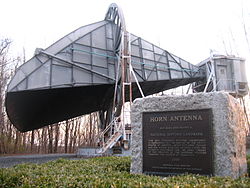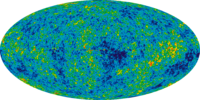- Discovery of cosmic microwave background radiation
-
This article concerns the accidental discovery of cosmic microwave background radiation. Although predicted by earlier theories, it was first found accidentally by Arno Penzias and Robert Woodrow Wilson as they experimented with the Holmdel Horn Antenna.
Contents
History
Timeline of the discovery of the CMB Important dates and persons 1946 George Gamow estimates a temperature of 50K 1946 Robert Dicke predicts a microwave background radiation temperature of "less than 20K" (ref: Helge Kragh), but later revised to 45K (ref: Stephen G. Brush) 1948 Ralph Alpher and Robert Herman re-estimate Gamow's estimate at 5K. 1949 Alpher and Herman re-re-estimate Gamow's estimate at 28K. 1960s Robert Dicke re-estimates an MBR (microwave background radiation) temperature of 40K (ref: Helge Kragh) 1964 A. G. Doroshkevich and Igor Novikov publish a brief paper, where they name the MBR phenomenon as detectable. 1960s Arno Penzias and Robert Woodrow Wilson measure the temperature to be approximately 3 K. By the middle of the 20th century, cosmologists had developed two different theories to explain the creation of the universe. Some supported the steady-state theory, which states that the universe has always existed and will continue to survive without noticeable change. Others believed in the Big Bang theory, which states that the universe was created in a massive explosion-like event about 13.7 billion years ago.
The first published recognition of the cosmic microwave background (CMB) radiation as a detectable phenomenon appeared in a brief paper by Soviet astrophysicists A. G. Doroshkevich and Igor Novikov, entitled "Mean Density of Radiation in the Metagalaxy and Certain Problems in Relativistic Cosmology", in the spring of 1964.[1]
Working at Bell Labs in Holmdel, New Jersey, in 1964, Arno Penzias and Robert Wilson were experimenting with a supersensitive, 6 meter (20 ft) horn antenna originally built to detect radio waves bounced off echo balloon satellites. To measure these faint radio waves, they had to eliminate all recognizable interference from their receiver. They removed the effects of radar and radio broadcasting, and suppressed interference from the heat in the receiver itself by cooling it with liquid helium to −269 °C, only 4 °C above absolute zero.
When Penzias and Wilson reduced their data they found a low, steady, mysterious noise that persisted in their receiver. This residual noise was 100 times more intense than they had expected, was evenly spread over the sky, and was present day and night. They were certain that the radiation they detected on a wavelength of 7.35 centimeters did not come from the Earth, the Sun, or our galaxy. After thoroughly checking their equipment, removing some pigeons nesting in the antenna and cleaning out the accumulated droppings, the noise remained. Both concluded that this noise was coming from outside our own galaxy—although they were not aware of any radio source that would account for it.
At that same time, Robert H. Dicke, Jim Peebles, and David Wilkinson, astrophysicists at Princeton University just 60 km (37 mi) away, were preparing to search for microwave radiation in this region of the spectrum. Dicke and his colleagues reasoned that the Big Bang must have scattered not only the matter that condensed into galaxies but also must have released a tremendous blast of radiation. With the proper instrumentation, this radiation should be detectable.
When a friend (Bernard F. Burke, Prof. of Physics at MIT) told Penzias about a preprint paper he had seen by Jim Peebles on the possibility of finding radiation left over from an explosion that filled the universe at the beginning of its existence, Penzias and Wilson began to realize the significance of their discovery. The characteristics of the radiation detected by Penzias and Wilson fit exactly the radiation predicted by Robert H. Dicke and his colleagues at Princeton University. Penzias called Dicke at Princeton, who immediately sent him a copy of the still-unpublished Peebles paper. Penzias read the paper and called Dicke again and invited him to Bell Labs to look at the Horn Antenna and listen to the background noise. Robert Dicke, P. J. E. Peebles, P. G. Roll and D. T. Wilkinson interpreted this radiation as a signature of the Big Bang.
To avoid potential conflict, they decided to publish their results jointly. Two notes were rushed to the Astrophysical Journal Letters. In the first, Dicke and his associates outlined the importance of cosmic background radiation as substantiation of the Big Bang Theory. In a second note, jointly signed by Penzias and Wilson titled, "A Measurement of Excess Antenna Temperature at 4080 Megacycles per Second," they noted the existence of the residual background noise and attributed a possible explanation to that given by Dicke in his companion letter.
In 1978, Penzias and Wilson were awarded the Nobel Prize for Physics for their joint discovery.
Bibliography
- Aaronson, Steve (January 1979). "The Light of Creation: An Interview with Arno A. Penzias and Robert W. Wilson". Bell Laboratories Record: 12–18.
- Abell, George O. (1982). Exploration of the Universe. 4th ed.. Philadelphia: Saunders College Publishing.
- Asimov, Isaac (1982). Asimov's Biographical Encyclopedia of Science and Technology. 2nd ed.. New York: Doubleday & Company, Inc..
- Bernstein, Jeremy (1984). Three Degrees Above Zero: Bell Labs in the Information Age. New York: Charles Scribner's Sons. ISBN 0684181703.
- Brush, Stephen G. (August 1992). "How Cosmology Became a Science". Scientific American 267 (2): 62–60. doi:10.1038/scientificamerican0892-62.
- Chown, Marcus (September 29, 1988). "A cosmic relic in three degrees". New Scientist: 51–55.
- Crawford, A.B.; D.C. Hogg and L.E. Hunt (July 1961). "Project Echo: A Horn-Reflector Antenna for Space Communication". The Bell System Technical Journal: 1095–1099.
- Dicke, R.H.; P. J. E. Peebles, P. J. Roll and D. T. Wilkinson (July 1965). "Cosmic Black-Body Radiation". Astrophysical Journal Letters 142: 414–419. Bibcode 1965ApJ...142..414D. doi:10.1086/148306.
- Disney, Michael (1984). The Hidden Universe. New York: Macmillan Publishing Company. ISBN 0025316702.
- Ferris, Timothy (1978). The Red Limit: The Search for the Edge of the Universe. 2nd ed.. New York: Quill Press.
- Friedman, Herbert (1975). The Amazing Universe. Washington, DC: National Geographic Society. ISBN 0870441795.
- Hey, J.S. (1973). The Evolution of Radio Astronomy. New York: Neale Watson Academic Publications, Inc.. ISBN 0882020277.
- Jastrow, Robert (1978). God and the Astronomers. New York: W. W. Norton & Company, Inc.. ISBN 0393011879.
- Kirby-Smith, H.T. (1976). U.S. Observatories: A Directory and Travel Guide. New York: Van Nostrand Reinhold Company. ISBN 0442244517.
- Learner, Richard (1981). Astronomy Through the Telescope. New York: Van Nostrand Reinhold Company. ISBN 0442258399.
- Penzias, A.A.; R. W. Wilson (July 1965). "A Measurement Of Excess Antenna Temperature At 4080 Mc/s". Astrophysical Journal Letters 142: 419–421. Bibcode 1965ApJ...142..419P. doi:10.1086/148307.
- Penzias, A.A.; R. W. Wilson (October 1965). "A Measurement of the Flux Density of CAS A At 4080 Mc/s". Astrophysical Journal Letters 142: 1149–1154. Bibcode 1965ApJ...142.1149P. doi:10.1086/148384.
External links and references
Citations
- ^ A. A. Penzias. "The origin of elements." (PDF). Nobel lecture. http://nobelprize.org/nobel_prizes/physics/laureates/1978/penzias-lecture.pdf. Retrieved October 4, 2006.
General
- "Astronomy and Astrophysics Horn Antenna.". National Park Service, Department of the Interior.
Cosmic microwave background radiation (CMB) Discovery of CMB radiation · List of CMB experiments · Timeline of CMB astronomy Effects Cosmic variance · Diffusion damping · Sachs–Wolfe effect · Sunyaev–Zel'dovich effect · Recombination · Thomson scattering
Space-based
experimentsBalloon
experimentsGround-based
experimentsCategories:
Wikimedia Foundation. 2010.


